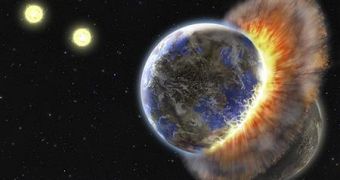By observing vast masses of dust accompanying a distant binary star system, US scientists concluded that it's possible that 2 planets similar to Earth violently collided 300 million light years away from us.
Benjamin Zuckerman, an astronomer at the University of California in Los Angeles, who worked on the study, explains: "It's as if Earth and Venus collided with each other. Astronomers have never seen anything like this before; apparently major, catastrophic, collisions can take place in a fully mature planetary system."
The observations made by a team at UCLA and another one at CIT (California Institute of Technology) involved the dust found in orbit of a star called BD +20 307, in the Aries constellation. Gregory Henry from the Tennessee State University, another scientist involved in the study, states that "If any life was present on either planet, the massive collision would have wiped out everything in a matter of minutes: the ultimate extinction event." When the system was first discovered, in 2005, it was believed to contain only one star. Actually, BD +20 307 is comprised of 2 stars, almost identical to our sun in size, mass and temperature, spinning around their common mass center about every 3 days and a half, and the system holds more warm dust in orbit than any previously observed star that is similar to Earth's sun.
"The planetary collision in BD +20 307 was not observed directly but, rather, was inferred from the extraordinary quantity of dust particles that orbit the binary pair at about the same distance as Earth and Venus are from our sun," added Henry. "If this dust does indeed point to the presence of terrestrial planets, then this represents the first known example of planets of any mass in orbit around a close binary star." Judging by Tennessee State’s Francis Fekel’s opinion, "This poses two very interesting questions. How do planetary orbits become destabilized in such an old, mature system? Could such a collision happen in our own solar system?" Further observations and calculations will hopefully answer these and many other questions related to the evolution of such celestial events.

 14 DAY TRIAL //
14 DAY TRIAL //